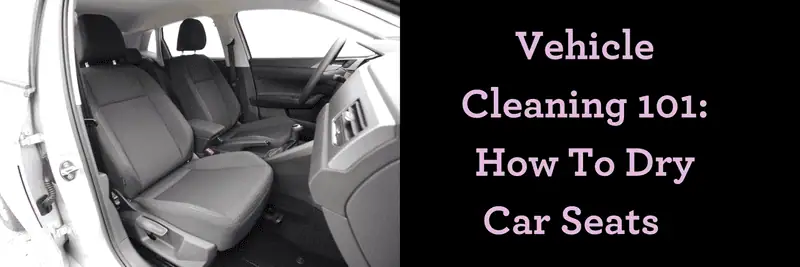Many vehicle owners are concerned about how to dry car seats effectively, especially after accidental spills or exposure to rain. Ensuring your car seats are thoroughly dried prevents unpleasant odors, mold growth, and potential damage to the upholstery. In this comprehensive guide, we’ll cover everything you need to know about drying car seats quickly and efficiently, regardless of the cause of wetness.
How To Dry Car Seats: Understanding Car Seat Materials
Different car seat materials determine how to dry car seats. Knowing the type of upholstery in your vehicle can help you choose the most effective drying method.
Types of Car Seat Materials
- Cloth Seats: These are highly absorbent and tend to hold moisture longer. They need thorough drying to prevent mold.
- Leather Seats: While less absorbent, they can crack or fade if dried improperly. Special care is needed to maintain their condition.
- Vinyl Seats: These are less absorbent and easier to dry but still require careful handling to avoid damage.
Initial Steps to Take When Car Seats Get Wet
When your car seats get wet, acting quickly can prevent further issues. Here are the initial steps you should take.
Immediate Actions
- Blot Excess Moisture: Use absorbent towels or microfiber cloths to soak up as much water as possible. Avoid rubbing to prevent fabric damage.
- Vacuuming: Employ a wet/dry vacuum to extract deeper moisture from the seats. This is particularly effective for cloth seats.
Effective Drying Techniques
Drying car seats can be achieved through various methods. Here are some of the most effective techniques.
Using Absorbent Towels and Air-Drying
- Blotting and Patting: Gently blot the seats with towels to prevent fabric damage. Repeat until no more moisture is absorbed.
- Air Circulation: Open windows and doors to allow airflow. This helps in evaporating the remaining moisture.
Fans and Blowers
- Positioning Fans: Point fans directly at the wettest areas to maximize airflow. Keep doors and windows open for better ventilation.
- Using Air Blowers: Effective for targeted drying, but keep at a safe distance to avoid heat damage.
Dehumidifiers and Desiccants
- Using Dehumidifiers: Place inside the car to reduce overall moisture. This is particularly useful in humid conditions.
- DIY Desiccants: Use rice or baking soda as moisture absorbers. Place them in mesh bags or sprinkle them directly on the seats, then vacuum them after several hours.
Heat Sources
- Portable Heaters and Hair Dryers: Use with caution to avoid overheating, especially on leather. Move the device constantly to distribute heat evenly.
- Sun Exposure: If possible, remove seats and place them in direct sunlight. This natural method can be very effective.
Specific Tips for Different Seasons
Drying techniques may vary depending on the season. Here are some tailored tips for winter and summer.
Drying in Winter
- Indoor Drying: Use portable heaters or space heaters in a garage to create a warm drying environment.
- Dehumidifiers: Essential in high-humidity conditions to extract moisture from the air.
Drying in Summer
- Sunlight: Utilize the heat from the sun for quicker drying. Ensure the car is parked in a sunny spot with windows slightly open for ventilation.
- Natural Ventilation: Open windows to increase airflow and speed up the drying process.
Preventing Future Moisture Issues
Preventive measures can save you the hassle of dealing with wet car seats in the future.
Protective Measures
- Waterproof Seat Covers: Invest in covers to prevent future water damage. These are especially useful if you frequently transport wet items or passengers.
- Quality Window Seals: Ensure seals are intact to prevent leaks. Regularly inspect and replace if necessary.
Routine Maintenance
- Regular Cleaning: Keep seats clean to reduce the risk of mold and mildew. Use appropriate cleaners for your seat material.
- Check for Leaks: Regularly inspect window and sunroof seals to ensure they are watertight.
Addressing Odors and Residual Moisture
Even after drying, odors and residual moisture can linger. Here’s how to tackle these issues effectively.
Deodorizing Seats
- Vinegar and Baking Soda Solution: A natural and effective method for odor removal. Mix equal parts of water and white vinegar, apply to the seats, then sprinkle baking soda and vacuum after it dries.
- Commercial Cleaners: Use products designed for car interiors that include mildewcides to prevent mold growth.
Professional Help
- When to Seek Professional Assistance: Persistent dampness and odors might require professional cleaning services. Experts have specialized equipment to thoroughly dry and deodorize car interiors.
Parting Thoughts
Properly drying your car seats is crucial to maintaining their condition and preventing damage. Understanding the different drying techniques and preventive measures ensures your car’s interior remains clean, dry, and odor-free. Whether dealing with minor spills or heavy rain, these tips will help you tackle moisture effectively and keep your vehicle in top shape.
Acting quickly and using the right methods are key to preventing long-term damage. With these strategies, you’ll be well-equipped to handle any moisture issues and enjoy a fresh, dry car interior.
Complement your interior maintenance with regular exterior washes at BLISS Car Wash for an even more comprehensive car care routine. With our commitment to eco-friendly practices and high-quality service, BLISS Car Wash helps keep your car looking its best, inside and out.
For a limited time, we offer our Unlimited Membership for just $10 for the first month. This means unlimited washes, VIP access, and the ability to wash your car at any of our locations. Gift your car the care it deserves. Experience the BLISS Advantage today.



